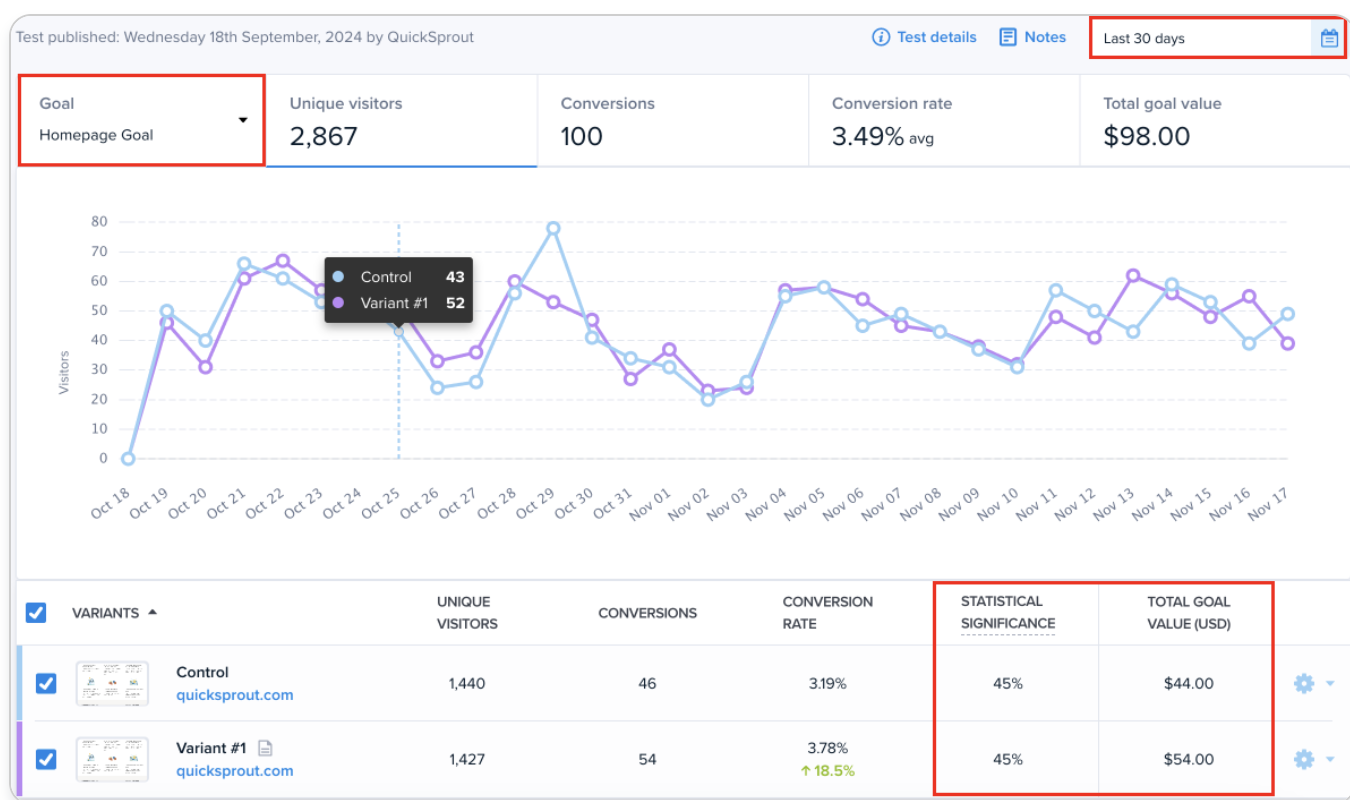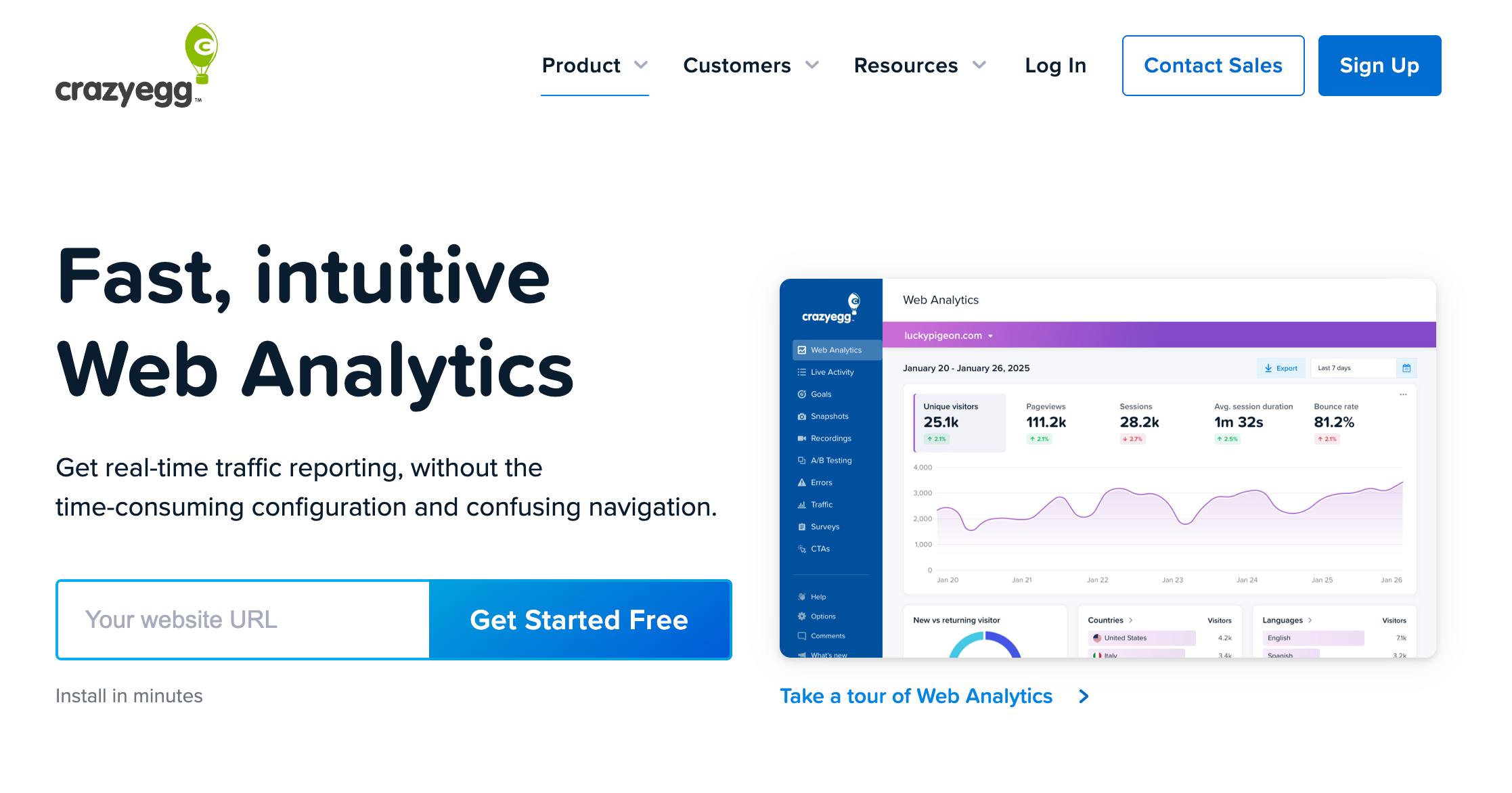Trying to decide whether to use Heap or Google Analytics? Heap is best if you don’t have time, energy, or interest in learning Google Analytics and want an intuitive tool. GA4 is best if you want to save money and take your time to learn to use it.
Heap vs. Google Analytics: A Quick Snapshot
Heap is a digital analytics platform that automatically captures user interactions on your website or app and offers insights into what users are doing.
Google Analytics is a popular app and website analytics platform with a robust free plan, plus a paid 360 version for enterprise businesses.
In this chart, see how the two stack up.
| Feature | Heap | Google Analytics (GA4) |
|---|---|---|
| Analytics | ✅ Variety of chart types ✅ Account-based & feature-level analytics ✅ AI chat, summaries, and follow-ups ⚠️ Heatmaps/session replays cost extra | ✅ Real-time reports & strong traffic insights ✅ Detailed acquisition & monetization reports ⚠️ Less intuitive interface, fewer chart types ❌ No heatmaps or session replays |
| Data Management | ✅ No-code event tagging & autocapture ✅ Shared or private dashboards ✅ Funnel alerts ⚠️ Alerts limited to higher tiers ⚠️ Harder to filter noise due to over-capture | ✅ Flexible data collection ✅ Admin API for automation at scale ✅ Custom tables, roll-up reporting (GA360 only) ⚠️ Manual tagging required ⚠️ Steep learning curve |
| Integrations | ✅ Heap Connect syncs data to warehouses (BigQuery, Redshift, Snowflake, S3) ✅ Integrates with Salesforce, Iterable, Marketo, Intercom ⚠️ Premium integrations locked to Pro & Premier tiers ⚠️ Limited partner ecosystem overall | ✅ Deep integration across Google Ads, BigQuery, Search Console, Looker Studio ✅ Data flow within Google ecosystem ⚠️ No native non-Google integrations |
| Security | ✅ SOC 2, GDPR, and CCPA compliant ✅ Encrypted data storage & employee security training ✅ No-code privacy configuration ⚠️ Advanced features only on enterprise tier | ✅ Enterprise-grade security with full encryption ✅Privacy tools ✅ Reliable Google Cloud infrastructure ⚠️ Cross-border data transfer concerns (esp. EU) |
| Support | ✅ Email support even for lower tiers ✅ Hands-on support & training for higher tiers ⚠️ Limited support hours for base plan ⚠️ No phone support unless add-on purchased | ✅ Extensive Help Center & tutorials ✅ Huge community of experts & resources ⚠️ No direct chat/email for free users ⚠️ Documentation can be dense and confusing |
Feature Breakdown: Heap vs. Google Analytics
1. Analytics
Heap
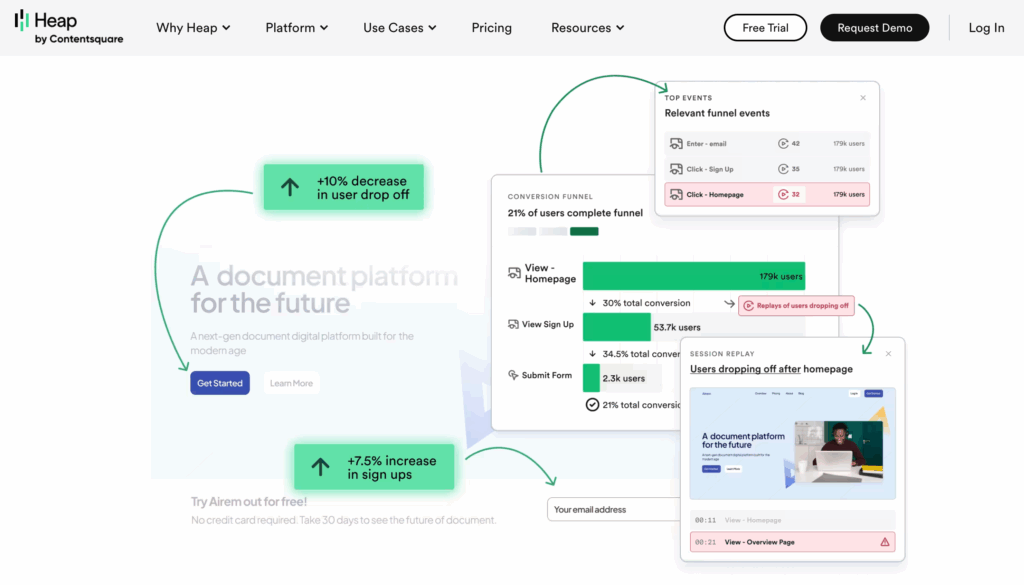
What I like:
- A variety of charts. I love the several different types of charts Heap offers for analyzing data and tracking KPIs. Google Analytics has some, but not all, of these chart varieties, so it’s worth noting here. I’ll go over some of my favorite Heap charts next.
- Funnel Charts. Get a bird’s-eye look at all the users who have performed a specific set of actions in your product or website.
- Journey Charts. Measure the individual paths people take as they use your product or website—these charts are customizable, so you can add or remove steps as it makes sense to do so.
- Retention Charts. Track which users come back to your site, which features they use, and how often they use them.
- Influence Charts. Analyze which marketing channels (like ads, vs. website content, vs. email marketing campaigns) have positively influenced users so you know what to spend your time on.
- Heatmaps, session replay, and error analysis. If you pay for two of the higher plan tiers, you can get heatmaps, session replays, and error analysis for an additional price.
- Engagement Matrix. If you pay for one of the top two plan tiers, you get Heap’s Engagement Matrix feature. This matrix allows you to measure the success of multiple web or app features from one dashboard—a four-quadrant scatterplot, to be precise. This is honestly a really nice feature to have, especially if you run multiple sites or have a feature-rich product and want to compare how well old or new features are performing.
- Account-based analytics. Do you run analytics for clients? With account-based analytics, B2B companies like yours can keep tabs on KPIs and churn for each account.
- Live data feed. See data come in as users go on your site and make sure tagging is working correctly with Heap’s live data feed, which you can pause if you want to take a closer look at what’s going on.
- AI summaries with Contentsquare. As a Contentsquare product, Heap offers a few key tools GA4 doesn’t: AI-powered chats, summaries, and follow-ups. With chats, you can ask the chatbot questions about your site or app’s performance and get answers in chart form. Need help understanding those charts? Summaries provide a description to help make it all click. Want to dig deeper? AI will suggest follow-up questions to help you get started.
What could use improving:
- The fact that heatmaps, session replays, and error tracking are add-ons. To be fair, Google Analytics doesn’t offer these features either. But it’s unfortunate that you can only access these key ways of visualizing data if you pay for a top-tier plan and an extra add-on fee.
Google Analytics
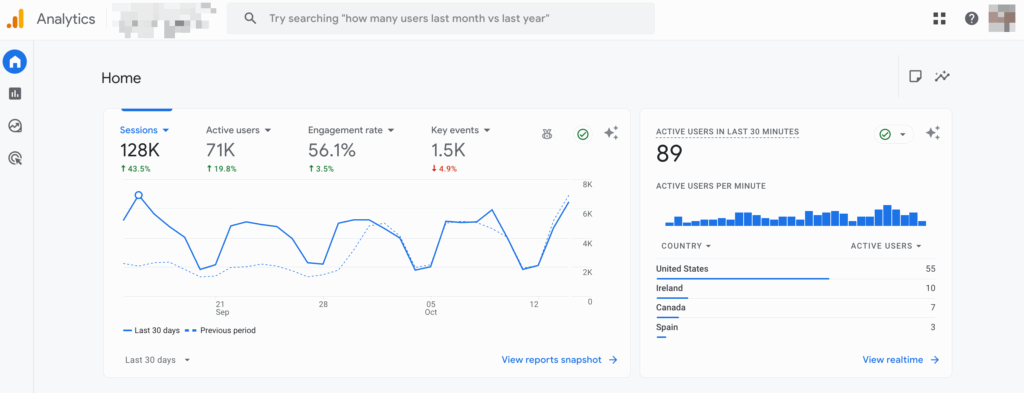
What I like:
- Real-time reporting. You can see activity on your site or app as it happens—more like within the past 30 minutes through the present—with Google Analytics’ Realtime Reports.
- Decent variety of charts and reports. While it doesn’t offer the comprehensive variety of charts Heap does, you do get a funnel builder with GA4, plus something similar to Heap’s Journey Charts with GA4’s User Explorer feature. There’s also a retention report like Heap’s Retention Chart, but nothing exactly like the Heap Influence Chart or Engagement Matrix features.
- In-depth traffic acquisition reports. Since it’s built on the most popular search engine in the world, GA4 offers unmatched insights into whether users reached your site or app through paid or organic traffic on Google.
- Events report. Gives you a close-up look at what users are doing—everything from clicks and page views to system-triggered actions or errors.
- Conversions report. Helps you see how your marketing channels work together to turn visits into valuable actions or sales.
- Pages and screens reports. See which web pages or app screens get the most engagement from your users.
- Monetization reports. These show how your product makes money—across ecommerce, subscriptions, in-app purchases, or ads—with deeper insights and advanced reporting options available in Analytics 360. (Along with the Conversions reports, I’d say the Monetization reports are the closest thing GA4 has to Heap’s Influence Charts.)
- Custom segmenting capabilities. Nested in its Explorations feature is GA4’s Segment Builder. This allowed you to create segments based on users and their characteristics/behaviors/demographics; event segments based on single actions (like purchasing or signing up for a newsletter) taken on your site or app; and session segments based on the sequence of activities in a user’s visit to your site or app.
What could use improving:
- Not as user-friendly. GA4 takes some getting used to—it’s less intuitive than Heap, with fewer visually pleasing charts. Some users report struggles with getting functions—like the User Explorer feature for understanding user journeys—to work at all. (We have a helpful guide to using Google Analytics if you need some extra guidance.)
- No heatmaps or session replays. You have to use a separate tool to get these valuable insights, which is a bummer.
2. Data Management
Heap
What I like:
- Super easy event tracking. You can tag and label events visually with no code, which makes it easy and beginner-friendly to set everything up.
- Collaborative dashboards. Teams can share dashboards with each other or keep them private to certain people, depending on whether you want a more communal vs. focused analysis.
- Automatic data capture. Heap logs nearly every interaction on your site or app right out of the box, but you can still bring in extra data through APIs if you need more depth (and have the dev skills).
- Helpful performance alerts. Funnel metric alerts keep you on top of conversion trends, which is super helpful. For instance, you’ll get an alert when key metrics shift up or down. This makes it easier and faster to respond to changes (and potential problems).
What could use improving:
- Limited access to alerts. Only top-tier customers get the funnel alerts, which feels unnecessarily restrictive to me. It does follow Heap’s pattern of restricting random things, like purchasing heatmapping and error tracking add-ons, to top-tier plans. Why can’t every paying user have all the nice things—or at least access to buy them?
- Less precision control. Autocapture is great for speed—it grabs almost every user interaction automatically—but that convenience can backfire. Because so much data is collected by default, it’s harder to spot which events really matter. It can be difficult to name them consistently or filter out the extra stuff once you do start to understand what you do and don’t need.
Google Analytics
What I like:
- Powerful data management options. GA4 gives you a lot of flexibility in how you collect and organize your data. You can pull in interaction data from just about any digital source—websites, mobile apps, or even third-party systems—using tools like SDKs, JavaScript libraries, and the Measurement Protocol. This means you’re not limited to what happens on your site. You can also connect (and therefore visualize) almost any touchpoint in your customer journey.
- Admin API convenience. The Admin API makes managing GA4 easier as you scale up, as long as you have a team that understands how to use it. With the Admin API, you can update settings, manage accounts, and automate repetitive tasks via programming. This can save you time spent clicking around in the interface for every little change you want to make.
- Advanced reporting extras. For teams on Analytics 360, GA4 offers premium reporting features like custom tables (for faster, more targeted analysis), improved data freshness (so reports update more quickly), and roll-up reporting (which combines data from multiple properties into a single view, a lot like Heap’s Engagement Matrix). These extras make it easier to see the full picture across large or complex organizations—but they’re only on Analytics 360.
What could use improving:
- Manual tagging required. GA4 doesn’t automatically capture user interactions the way Heap does. Instead, you have to set up custom events yourself through Google Tag Manager or by editing your site’s code. This adds extra steps to implementation and can slow down your analytics setup. Especially if you have to learn it all from the ground up. It also means you might miss key events if they’re not tagged correctly from the start.
- Steep learning curve. GA4 can be powerful, but as I’ve said before, it’s not exactly beginner-friendly. This becomes super clear when it comes to GA4’s data management features. The interface is less intuitive than previous versions of Google Analytics, and core features—like setting up reports, custom dimensions, or event tracking—take some getting used to. Lots of users find the terminology and navigation confusing at first, which can make GA4 frustrating to use if you’re used to simpler, more visual tools like Heap.
3. Integrations
Heap
- Strong data syncing with Heap Connect. Heap makes it easy to push your analytics data into major data warehouses like Redshift, BigQuery, Snowflake, or S3. The managed extract, transform, and load (ETL) process handles syncing automatically and even does it retroactively. This allows you to analyze historical user behavior without redoing your whole setup. However, it’s only available on the top two tiers of Heap plans.
- Smooth integrations with several marketing and engagement tools. Heap connects directly with platforms like Salesforce, Iterable, Marketo, and Intercom. This makes it easy to feed behavioral insights into your customer campaigns and engagement workflows.
- Personalized outreach with Heap Activate. Activate lets you send user segments directly into your marketing tools for highly targeted, data-driven messaging. This is great for personalization at scale, but it’s only available in the top two tiers.
What could use improving:
- Paywalled features. Heap Activate and Heap Connect are only available as an add-on for Pro or Premier plans, which limits their access for smaller teams who could still benefit from this functionality.
- Limited native partner ecosystem. While Heap’s integrations cover key analytics and marketing tools, there’s still room for more built-in connections beyond the major players. (Still, what Heap offers is more than what Google Analytics does.)
Google Analytics
What I like:
- Deep Google ecosystem integration. GA4 fits naturally into Google’s ecosystem. It links smoothly with tools like Google Ads, BigQuery, Search Console, and Looker Studio. Together, these allow for unified campaign tracking, audience targeting, and advanced data analysis, all in one Google ecosystem. (It’s not the tidiest system, but I digress.)
- Reliable performance and shared data foundation. Because all the integrations are part of Google’s infrastructure, your data flows are stable, secure, and consistent across all your Google tools, including Google Analytics.
What could be improved:
- Closed ecosystem trade-offs. While the tight Google-brand integrations are powerful, they’re a closed system. GA4 doesn’t have native integrations with non-Google platforms. You have to use a GA4 integration on a third-party tool to push data from the other side, which is annoying and can feel restrictive. Why can’t Google be like other analytics tools and just play nice with other platforms?
4. Security
Heap
What I like:
- Strong security foundation. Heap takes data protection seriously. It’s GDPR compliant, CCPA compliant, SOC-2 certified, and more. Its data is stored in a SOC 2 facility with strict controls and alarms to detect intrusions. Plus, according to Heap, all employees must go through security training with continuing education on best practices. Third-party audits happen regularly, too.
- No-code configuration. You can adjust the settings for your privacy and security without touching code, which adds to Heap’s user-friendliness, especially over a competitor like GA4.
What could use improving:
- Advanced features are gated. While all plan levels get SSO, closed projects and environments, and basic project permissions, only enterprise users get higher-level features like audit logs and SCIM provisioning.
Google Analytics
What I like:
- Enterprise-grade protection. GA4 benefits from Google’s massive security infrastructure—data is encrypted both in transit and at rest, and strict access controls mean only authorized users can view sensitive information. As you can see in the screenshot above, there are many words you can read about how GA4 keeps your data secure.
- Privacy-focused features. GA4 includes tools that make it easier to comply with privacy laws like GDPR and CCPA. You can anonymize IP addresses, manage how long user data is stored, and control whether certain personal identifiers (like precise location or user IDs) are collected at all.
- High reliability. Because GA4 runs on the same global infrastructure that powers Google Cloud and Search, it’s fast, stable, and very resilient. Downtime is rare, and Google’s scale means your analytics data is stored securely and redundantly across multiple data centers.
What could use improving:
- Data privacy concerns. Some organizations—especially in the EU—are cautious about cross-border data transfers and Google’s handling of personal data.
5. Support
Heap
What I like:
- Responsive, human support. Heap’s support team tends to be more hands-on than GA4’s, especially for higher-tier customers who need guidance with setup or troubleshooting. But still, even lower-tier customers do get some email support, which is more than Google can say.
- Helpful in-product resources. Built-in tooltips, guides, and documentation make it easier to learn the platform without heavy onboarding. Plus, every Heap user gets access to the Heap Community forums and Heap University (aka Heap’s knowledge base). All paying users get basic technical support.
- Lots of hands-on support for higher-paying customers. In Heap’s two top tiers, you get what Heap calls “standard support” in addition to basic technical support. You also get training sessions with Heap experts, the opportunity to buy a package with even more support, and a customer success manager. Enterprise users get premium support baked into their plan. For full details, see Heap’s support offerings page.
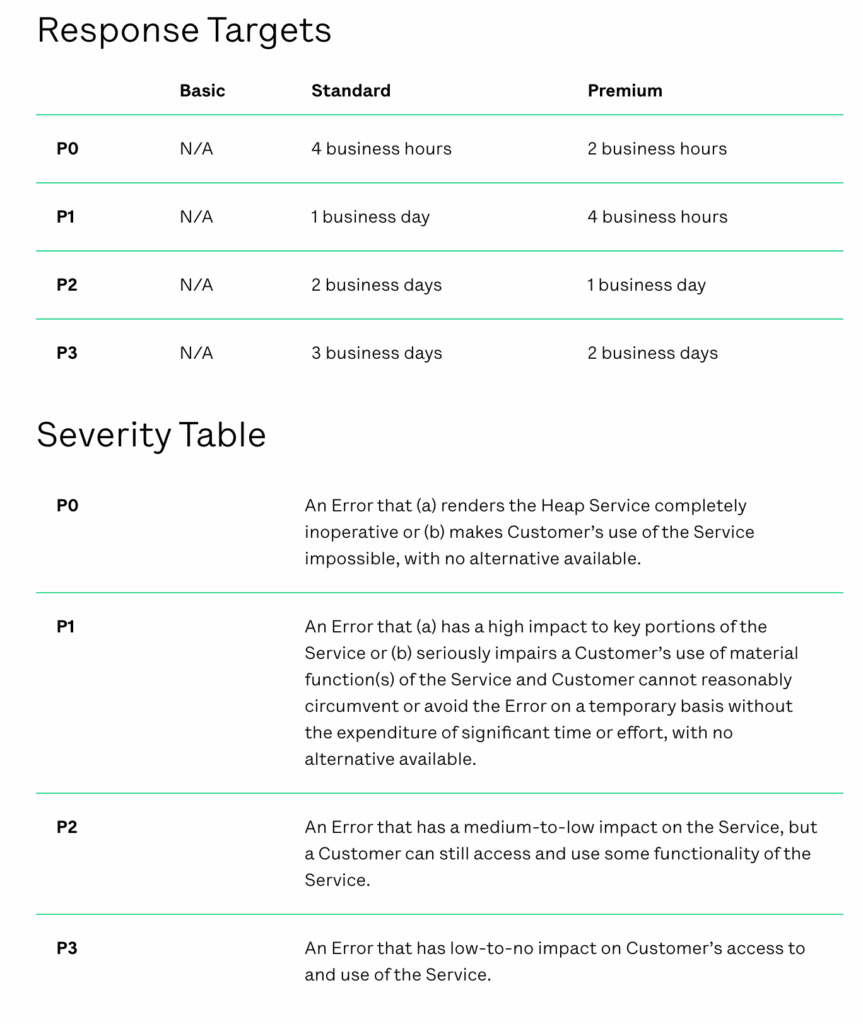
What could use improving:
- Limited support for lower plan tiers. If you use Heap’s free version or pay for the base plan, you only get email support in the 9 AM – 5 PM EST time zone. The Standard plan gets you a few more time zones for sending and receiving emails, but phone support is still not available unless you pay extra for a professional services add-on.
Google Analytics
What I like:
- Extensive documentation. Google’s Help Center is packed with tutorials, walkthroughs, and troubleshooting guides for every feature, although they’re dense and sometimes hard to follow.
- Scalable support for enterprises. GA360 customers get access to dedicated support channels and service-level agreements, often through certified Google partners who help manage setup, troubleshooting, and account optimization.
- Strong learning ecosystem. Because GA4 is so widely used, there’s a massive community of users, experts, and free resources to learn from, both on official Google Analytics forums and on third-party platforms like Reddit.
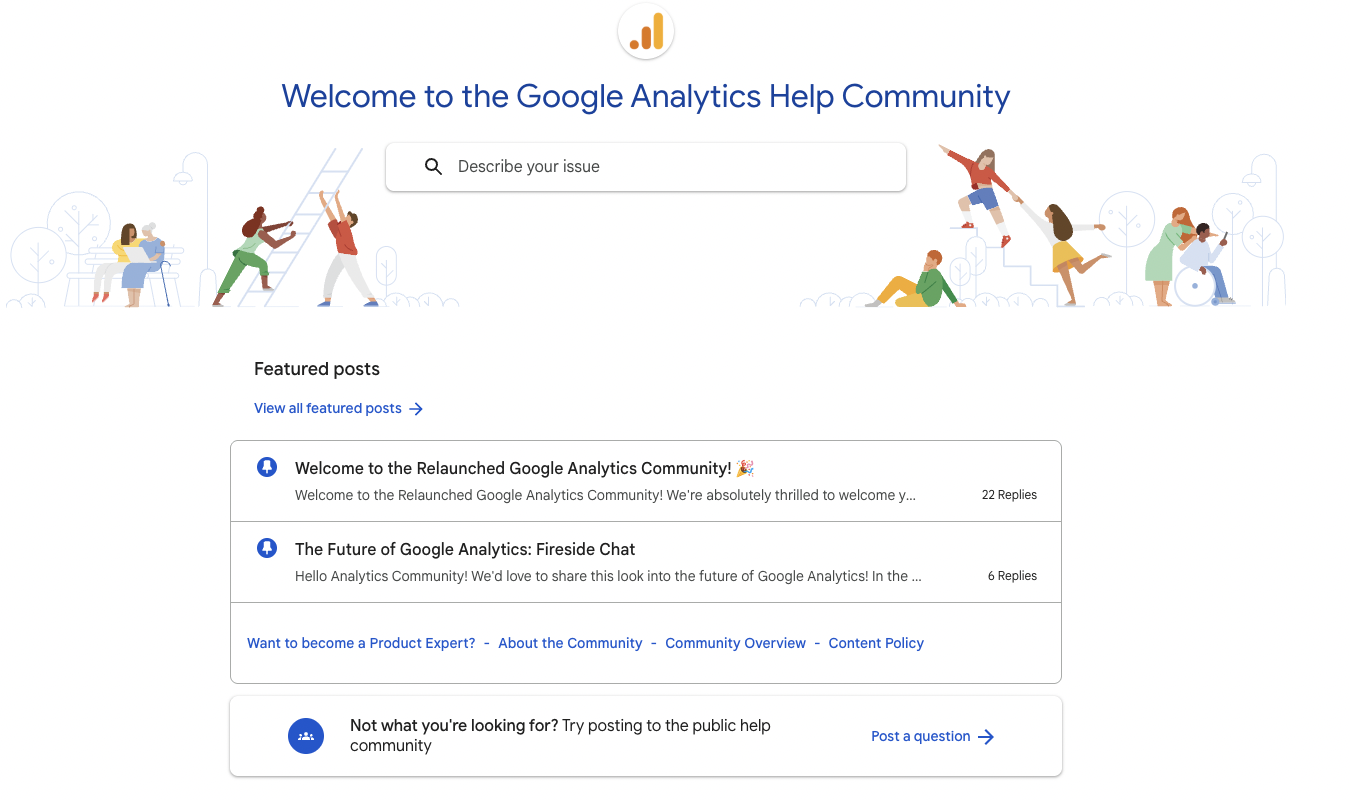
What could use improving:
- Limited direct support. If you use GA4 for free, you’ll have to rely on forums or documentation. There is zero direct chat or email support from the Google Analytics team itself. In my opinion, this is a huge negative and seems like something Google could certainly afford to fix if it wanted to.
Pricing Breakdown: Which Has the Best Value?
| Plan Tier | Heap | Google Analytics (GA4) |
|---|---|---|
| Entry-level | Free ✅ Autocapture of all events (no coding) ✅ Core dashboards & reports ⚠️ Limited data retention (up to 1 year) ⚠️ Basic support (docs + community only) | Free ✅ Unlimited data collection (within property limits) ✅ Built-in lifecycle & engagement reports ✅ Analytics Intelligence (automated insights) ⚠️ Data retention 2–14 months ⚠️ Community support only |
| Mid-range | Pro – not officially published, but reports are in the $25,000/year or higher range ✅ Advanced analysis tools (funnels, retention, paths) ✅ Shared dashboards & team collaboration ✅ Heap Connect (data warehouse sync) ⚠️ Heap Activate add-on costs extra | ❌ No true mid-tier — GA jumps from free to enterprise |
| High-end | Premier – custom pricing ✅ Full data governance & permissions ✅ Heap Activate (personalized data activation) ✅ Advanced alerts & dedicated CSM ✅ Enterprise security & compliance | GA360 – not officially published but reported to start around $50K/year ✅ Up to 50-month data retention ✅ BigQuery export included ✅ Email/chat support + SLAs ✅ Enterprise-level integration with Google Ads & Marketing Platform |
| Trial Period | Free plan available forever | Free plan available forever |
If you can get away with just using Heap’s free plan tier, it offers a good value, especially considering how much easier it is to use than GA4. But user reports state that Heap can get very pricey, very quickly, which is a major downside.
GA4 offers more for what makes you pay—which is nothing, unless you want the 360 version, which most SMBs don’t need. But the learning curve is much steeper than it is for a product like Heap and its competitors—including Mixpanel and Amplitude, which, like Heap, are more user-friendly. We broke down the key differences between Mixpanel and Google Analytics here.
Final Verdict: Is Heap or Google Analytics Right for You?
Heap is a solid tool to use if you have deep pockets and little time to learn GA4’s complicated setup and want something easy, intuitive, and convenient. GA4 offers better value for what you get, but it’s harder to get comfortable with.
If you need another alternative to Heap, Crazy Egg has a free plan that includes web analytics. We designed it to be extremely easy to use. If you hate Google Analytics and don’t want to pay the price of other tools, it could be exactly what you’ve been looking for.
Heatmapping and session replay come built in, along with surveys, A/B testing, error tracking, pop-up CTAs, web analytics, and conversion analytics.
Plus, pricing is affordable and transparent across all tiers—something neither Heap nor Google Analytics can say.




